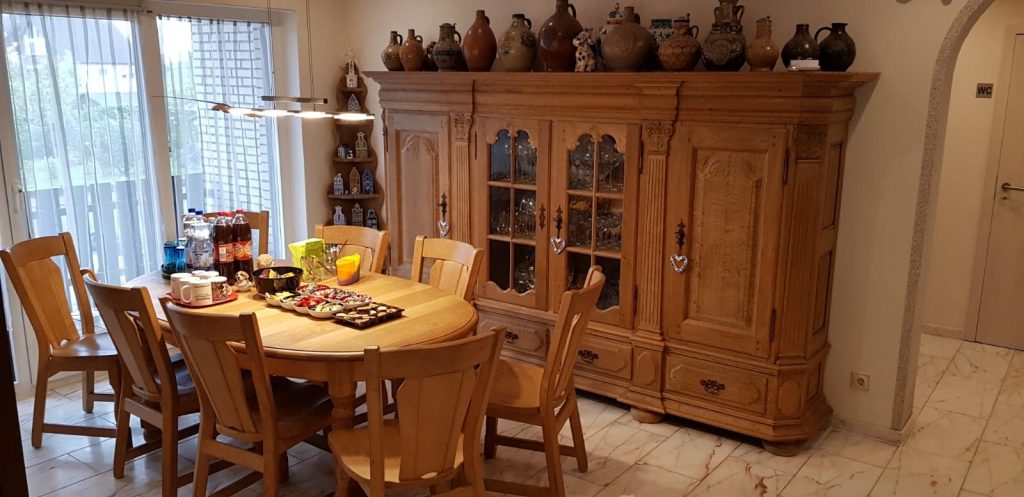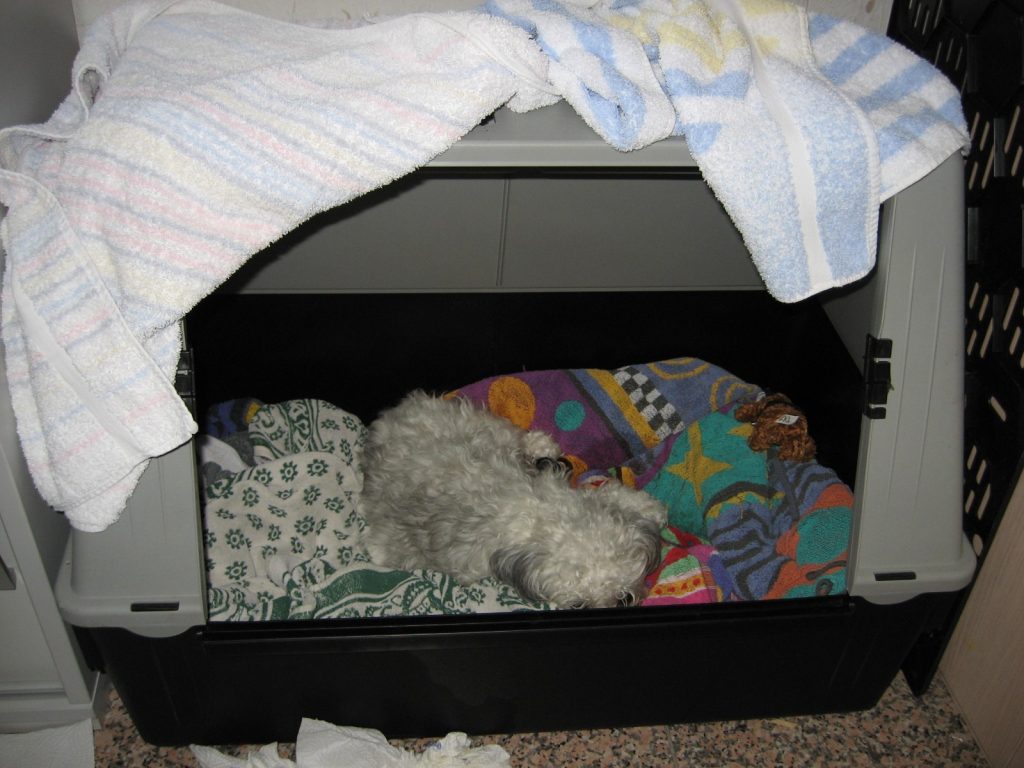This is how it starts with us
Dear puppy buyers,
Although we see our dog breeding as a hobby, we are commercial breeders and therefore entrepreneurs.
Due to the number of our dogs and the associated litters, we are registered as breeders with the responsible veterinary office here in the Rhein-Erft district.
This means that we have certain guidelines for our breeding. Of course, we want to adhere to these guidelines and also pursue our own set standards and breeding goals.
This also includes providing our buyers with the necessary expertise so that they have the knowledge, skills and opportunities required to raise and keep a dog.
Buyers should also be aware that a young dog in particular must be raised and kept in a species-appropriate manner and must not be overtaxed under any circumstances.
As the buyer, you also assure us that you will keep the dog in accordance with the provisions of the Animal Welfare Act and the regulations issued on the basis of this Act.
We would like to draw your attention to the fact that you as a buyer must comply with the municipal legal regulations and the road traffic regulations, in this case §28 Animals.
For dogs under 40 cm or under 20 kg, there are often no specific guidelines regarding the age at which children are allowed to walk dogs.
However, the following should be noted urgently:
Anyone who keeps dogs outside the enclosed property must be physically and mentally capable and offer the guarantee of being able to supervise the dog at all times in such a way that people, animals or property are not endangered.
Therefore, only a person capable of supervision should walk a dog. The dog owner is always liable; in the event of gross negligence, it is possible that no insurance will cover the damage.
Here is a brief insight into what you can expect during your weekly puppy visits with us:
- We answer your questions about the Bolonka and the puppy
- We talk about training and dog school
- We will work with you to decide which bag or crate is most suitable for transporting your puppy and your needs. We will also talk to you about suitable baskets and resting places.
- Grooming the Bolonka yourself or with a groomer. What do I need for this? How does it work? How often? We practise together on my adult dogs how to brush and groom a Bolonka.
- Topic leash, harness, collar and drag line. We will discuss with you what is suitable for you and your puppy and show you examples of what is possible.
- Feed and nutrition are discussed.
In week 7 we would like to discuss the final details for the puppy’s move to its new home. Answer any open questions. Arrange an appointment for the pick-up.
In week 8 the vet visit is due, we will gladly try to arrange the appointment so that you can accompany us and your puppy. When you visit us, you will receive the puppy packs for your puppy and the information material. This gives you time in the last week to look through everything at your leisure.
From week 9 the time has come for you to pick up your puppy! With some final good advice, we release you and your puppy into the big wide world!
The weekly visits with us are of course voluntary. We are happy to offer you the opportunity to watch your puppy grow up with us and would like to slowly introduce you to your new role through your visits. We hope that you will be optimally prepared for the puppy adventure!

Welcome to our living room 🙂 Today there will be the first info file for you, because we are now complete. Every puppy has found its home and we would like to prepare you for your puppy adventure. Well, this is what it would have looked like if everything had been normal 🙂
How does it all start for us?
The pregnant dog sleeps in our bedroom for the last few days before giving birth. She gets a nice soft box.


I accompany the bitch during the birth phase and am usually more nervous than the bitch 🙂

Our first litter in September 2006 from Heidi, a total disaster with a caesarean section and another emergency operation after the stitches didn’t hold.
Lotte, Nero and Monti were our first puppies and almost the only ones.
At that time, I imagined dog breeding to be very simple and was confronted with the reality directly with my first litter. This had a big impact on me and showed me that I can be grateful for every litter without complications. Books say that the mortality rate in the first 12 weeks is around 15%.
The birth and further rearing are therefore always associated with a risk. Nevertheless, our puppies can be reserved by interested parties immediately after birth. We should always be aware that a puppy can still die in the first 8 weeks, it is a small, delicate creature.
The first 14 days, the neonatal phase, are a challenge for us. During this time, the bitch and her puppies stay with us in the bedroom, separated from the other bitches.
At birth, the puppies are still blind, deaf and cannot maintain their body temperature on their own. They are therefore dependent on the mother’s body heat. In the first 2 weeks, it happens again and again that a puppy “crawls away” or the bitch lies down differently in the box. Then it gets loud in the box, because cold and lonely puppies cry loudly for their mother.
Then we get into action, get up and see what’s going on. Put the puppies back on and wait until everything has calmed down. There are litters that are very easy to look after and very happy, but there are also litters that are very noisy at night J
They often just whine loudly if the milk doesn’t flow fast enough or they don’t get enough. The puppies usually manage to double their birth weight in the first 10 days.
After around 12 to 15 days, the puppies manage to regulate their own body temperature, their eyes open and shortly afterwards their ears also open. The puppies are now much more aware of their surroundings and become more active.
This is the time when the puppies leave the bedroom and move into the living room. The mother is usually relaxed again with the other females. Sometimes even one or two other females are now allowed to help with the rearing and are tolerated in the nest.

From the 3rd week, the puppies start to play with their littermates.
They start to leave the nest and expand their horizons 🙂 Unfortunately, they often don’t find their way back to the nest on their own and then report loudly. This is where our help is needed again, of course also at night 🙂
By the time they are 4 weeks old, they have already discovered food and water. Due to the change from pure milk food to dry food, the puppies often get tummy rumblings. Their stools become firmer and the changeover takes a few days. Slowly they are also ready to use the whole run and find their way back to the nest on their own.
At the latest now all other bitches are allowed to see the puppies, the mother bitch has nothing against it.
Slowly the milk teeth begin to grow and at 5 to 6 weeks they can be clearly felt. Now the puppies’ brains are fully active and the socialization phase is in full swing. External stimulation is now particularly important for the puppies’ mental development. We now offer the puppies as many different new things as possible to get to know and try out.
Now we need to offer the puppies variety and meaningful activity.
The scuffles between them get louder and louder. Now the other bitches are in demand as teachers of good behavior. The puppies now learn some new things from them by observing and imitating. The social play now really begins and the puppies get their first education about bite inhibition, they learn that their behavior has consequences. We are responsible for teaching the puppies above all that they should avoid feet 🙂 This is also something they have to learn first.
Experience and advice on a wide range of topics relating to the
Bolonka Zwetna from Andrea, Tobias and Hubert Walkenhaus
Probably the most tender temptation since dogs have existed: The Bolonka Zwetna







